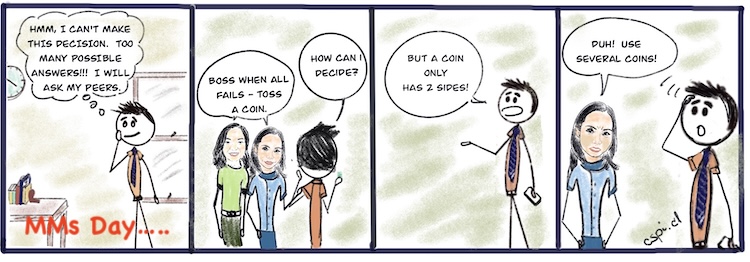This article introduces you to critical thinking that can be is used with great effect in decision-making.
Critical thinking. The phrase has the word ‘critical’ in it. This could mean vitally important. Or it could mean being suspicious. In critical, thinking, it is about being suspicious of information, data, observations , assumptions that are used in answering some question. And asking questions is the heart of critical thinking.
Google can help in demonstrating the value of questions – useful questions. Critical thinking begins with deciding on the question(s) to ask.
Imagine that you are deciding whether coffee is good for your heart . Should you continue drinking coffee or remove it from your lfe. Let’s ask two questions:
1. Is coffee good for the heart?
2. Is coffee bad for the heart?
You decide to avoid misinformation, so you look only for peer reviewed research. Peer reviewed means that others have verified the research findings published. The reason for the two questions is to introduce different viewpoints for you to think about.
Armed with several research papers to read, what do you do? Ask a new question!
“Which research papers are relevant to my decision to keep coffee in my life or not?”
You might find that some research was done on a very specific group of people. That group might live in an area of the world where diet and climate are unique. Who is to say that there were not many other variables that would account for the level of heart problems found in the research? Is the control group they used valid? Maybe they looked for non drinkers of coffee. Buy maybe those who did not drink coffee tended to be people who also exercised, practised yoga and were primarily vegetarian in the diet. Or you find the research was done on people over the age of 60? Maybe there are other health issues that can bias the results.
The same might apply to research that said coffee is good for your heart. Who paid for the research? If it was a well known branded coffee maker you might be suspicious of the results. This certainly is the case with many medical papers that are sponsored by the manufacturers of specific drugs.
Note that critical thinking hinges off asking questions and being suspicious or curious about the answers.
If you have done this research properly and analyzed the results, you will find that all you can say about coffee and the heart is that it may or may not be good for the heart. You might also say you cannot say for certainty whether it is bad for the heart.
So what is your decision? You might ask: “How much coffee was used in the ‘coffee is bad for the heart research’?” and vice versa. Maybe you then decide that too much coffee is risky and so you will limit you intake to two cups a day.

Today ,with the use of Google, you will find many people who are holding ideas that have not been critically assessed.
Critical thinking is being a curious detective. Ybeing curious means that you have an open mind and willing to consider all points of view. You seek clues, to help you come to a solution or an answer. At the same time, you are objective, letting clues that work against the answer that you might have expected, into your thinking. Many crime novels portray a defence attorney highlighting a clue that was ignored by the prosecutor leading to a ‘not guilty’ verdict.
I enjoy reading books that feature legal arguments in court. Frequently the defence attorney attacks the detectives for jumping to conclusions too early, and therefore not investigating people other than the defendant in the case. The reasons suggested as to why this happens, include the detectives having too much on their plate, being under pressure from politicians to resolve the case, or simply believing that they had sufficient evidence to convict the defendant and so ‘case closed’.
The same happens in business. We are busy. We have deadlines to meet. We have decisions to make. And this leads us to not be suspicious of the information that we have, or open to counter arguments. So, we jump at the first decision that seems good and go from there.
This is why in the previous article on decision-making I stress the importance of questions. Questions are the doorway to critical thinking.
The following steps can be used to increase your capability as a critical thinker.
Steps of Critical Thinking
1. Identify the problem or question.
Be as precise as possible: the narrower the issue, the easier it is to find solutions or answers. “Should I drink coffee?” is broad. “Is coffee good for the heart” is specific.
2. Gather data, opinions, and arguments.
Try to find several sources that present different ideas and points of view. Learn to welcome the views of people that differ from yours. Note that opinions are, by definition, unsupported by facts and data. If they are supported by facts, they cease to be an opinion and become an argument. But always be suspicious of ‘facts’. A fact should be irrefutable otherwise it drops back to being an opinion.
3. Analyze and evaluate the data.
Do I have enough data? Is the data valid – check source. Is there enough information or data to support my thoughts? Is there a trend in the data or is it simply a single point of data? Y to look for a it’s hard to find hard to find find your eyes white around it noou need to be able to tell the story behind data.
I once attended a meeting in which the slide on the screen consisted of a single bar chart in a colourful PowerPoint slide. It was a single datapoint and we had no idea why the presenter had used a graph to indicate a single point of data. When asked what the data meant, the presenter was flummoxed as she had no story behind why she highlighted that datapoint on a slide.
For example, a trend that is going up at 10% per year without a story, might suggest that the trend will continue to at 10% per year. Meanwhile, the real story might indicate that the growth was only 10% in the last year because of some extraordinary revenue event. The market is softening and to continue at 10% a new strategy is needed or it needs to be accepted that the 10% will not continue.
Many questions asked of a presenter are critical thinking in action. They are curious and suspicious.
4. Identify assumptions.
You might obtain data and someone’s opinion as to what the data means. What assumptions are they making? Also check your own assumptions. This is very important for optimists. Wishing something good to happen without a clear plan as to how to achieve the ‘good’ suggests wrong assumptions or simply an opinion. Revenue and costs are the two big numbers that senior managers watch. Both are subject to assumptions that force higher revenue numbers and lower cost numbers without clear ways in which they will be achieved. As a manager you want to ask yourself : ‘what assumptions are being made or am I making?’
5. Determine valuable information.
Some information will be more important to your decision than others. From all the data that you have collected, and the opinions and arguments that you have heard, select those that you feel are supporting the purpose of the decision that you need to make. In critical thinking it is often a conclusion that you come to, as opposed to a decision.
6. Make a decision/reach a conclusion.
Identify various conclusions or decisions that are possible and decide which (if any) of them are sufficiently supported. Weigh strengths and limitations of all possible options. Consider the downside risks of various alternatives.
7. Present or communicate.
Once you’ve reached a conclusion you can make your decision and support it in any situation.
Critical Thinking
Critical thinking can be used in many different areas and ways:
– Using the 5 why’s
– Finding root causes
– Exploring the history of an idea, situation
– Keeping opinions, ideas, beliefs, observations, and facts apart in your thinking
– First principle thinking. Study real work required to be done before entering into a contract, question the requirements.
– Ask first principle questions – Elon Musk “Why do rockets costs so much when materials are only 10% of the cost?”
– Challenge or critique things and the assumptions underlying them.
I have a client whose job he believes it is to be paranoid and question everything. In fact, observing him in action, he is simply thinking critically.
Having said all that, to decide in a timely manner you must avoid overthinking. Overthinking means doing the same thing repeatedly and getting nowhere. Try these two things: Toss a coin to decide, and when you see ‘head’ or ‘tails’ notice how you feel. That might clue you into the decision. you favour. Another idea comes from a Harvard business article, of which I cannot remember the date. It is the 10/10/10 idea. Ask ‘what I will think of my decision in 10 minutes, 10 weeks, 10 months?’ As you think, often, it becomes apparent that you can stop overthinking and make the decision.
Be a detective, be suspicious, be curious, ask questions and think deeply.
